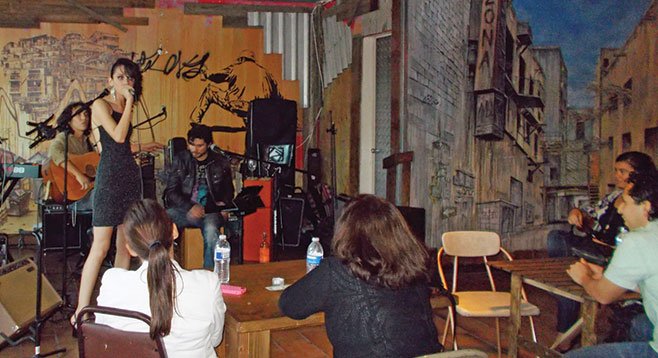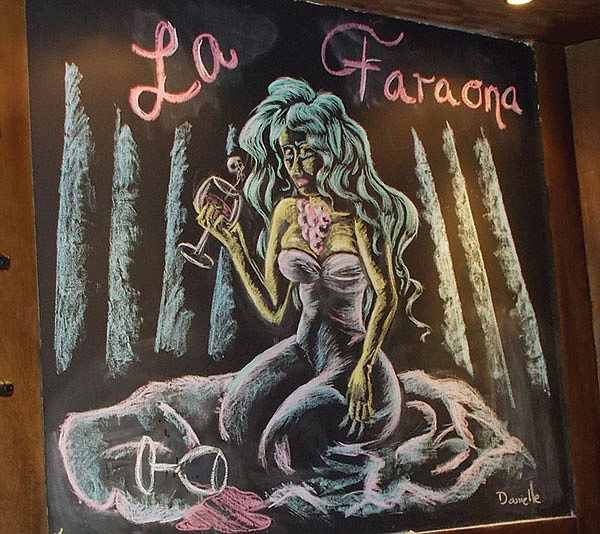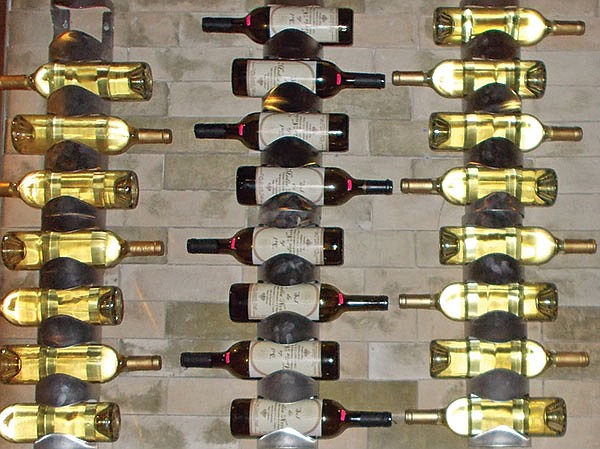 Facebook
Facebook
 X
X
 Instagram
Instagram
 TikTok
TikTok
 Youtube
Youtube

"La Faraona?” says Danielle. “She was a dancer, back in the glory days of Agua Caliente, here in Tijuana. Anita. She danced passionately, Andalusia-style. Flamenco. She poisoned her lover and herself when he stopped loving her. They say you can see her ghost dancing out from the minaret when the moon is full…”
Wow. Danielle’s telling me how come they’ve called their place “La Faraona” — the Lady Pharaoh.
I mean, what luck. There I was in TJ, wandering down Puente Mexico, aka First Street, at 10:00 at night. Heading back to the border. Only one blob of light, a cantina, open, then nothing, except for a little low-lit woody balcony loaded with a clump of people burbling away.

I could see banners below them. One said something about tea, another about “micro-teatro,” and a third said, “La Faraona.” Natch, had to climb the steps to see what was going on.
And inside? Oh, this is great. A wine bar, a coffee place, really good original murals. Brand new. Looks old.
I take a seat at the bar and this gal Danielle comes up.
“Do you have anything to eat?” I ask.
“Of course,” she says. She has a merry eye. “But right now, it’s just our cheese plate. We make all our own cheeses and bread. These are our wines, too.”
She points to the bottles that are kinda stored sideways, gripped by clasps on the lighted wall behind.
“Sol de Media Noche,” says the chalkboard menu.
“Midnight Sun,” Danielle translates. “That’s the wine our Aunt Lupita makes down in the Valle de Guadalupe, along with the cheeses and breads.”
What the heck. I ask for the cheese plate (about $5) and a glass of “70/30” (wines start at about $3).
“It’s 70 percent cabernet sauvignon, 30 percent tempranillo, a young wine.” This is David, who’s standing with Danielle here at the bar. They were childhood friends, and he and Danielle and her brothers, Oscar and Jorge, started this place along with Aunt Lupita down in Guadalupe Valley, east of Ensenada.
“Lupita was a journalist here in TJ, until the bad times came,” David says. “Two years ago, she found a tiny piece of land in Guadalupe Valley and went down to produce cheeses and breads and wine. Already she has a good business. She doesn’t actually grow the grapes — not yet, anyway. She’s been buying wine from nearby vineyards and mixing it and putting it out under her own label. But she’s in the process of buying land so she can grow her own grapes. ”
David says opening here on First Street gives Aunt Lupita a local outlet in Tijuana. “And it lets us create a little center for culture, too. The micro theater was coming in to this building regularly, and they said, ‘Why don’t you join us?’ Wine-bar theaters are pretty hot in Spain right now. So, here you can get a glass of wine, go upstairs, watch one of the four plays they put on or all of them — they’re only 15 minutes each — then come back down, eat, meet friends, whatever.”

He brings me this glass of light-red wine. I sip it.
“It’s sweet, light, what we call an entry-level wine,” says David.
It’s sweet, all right, but not cloying, thank goodness. And light, but not watery.
My cheese plate arrives, three different cheeses splayed out in rows of half a dozen or more slices each. One’s stained yellow and brown, the next is yellow with a greenish rind, and the third is sweaty and milky. (Goat cheese?)
Next to the cheeses are three pots of salsa, one red and two greens. But they’re different from standard salsas, filled with bits of plants, looks like, and solid things I really can’t identify.
And on top of all this, you also get a basket of lightly baked and sliced baguette.
“That’s from our aunt, too,” says Danielle. “She bakes it down there and sends it up.”
So, hey, endless combo possibilities here. I start off loading a slice of the bread with the darkest cheese.
“That’s the ‘Cuatro Chiles,’” says Danielle. “Chile morita, jalapeño, chipotle, and chiltepin” (the only wild chili native to the U.S., turns out). I load some of the red salsa on top. It’s a mix of sun-dried tomatoes with goat cheese. Dee-lish.
A slurp of the Midnight Sun, then I grab the second cheese. This one’s “A la Leña” (firewood).
“Lupita covers it in the ash of olivewood,” says Danielle.
I add some salsa from the middle, mushy-green pot.
“Tapenade,” Danielle says when I ask. “Olives, capers, peppers.”
What a combo. You can taste the woodiness and olive infusion in the cheese, for sure, enhanced by the olives on top.
The last, a white cheese, is called “Oreado.”
Say what?
“It sort of means ‘sweaty,’” David says. “It’s French style, maybe a bit like brie, camembert.”
Or queso fresco, maybe. It’s squishier, lighter, which is good combined with the last little salsa pot, because that one’s assertive, dryish, tangy. Parsley? Oregano? Cilantro? It’s chimichurri, David explains, the Argentine steak rub. Lumpy, sticky.
Now I have to try all the other possible flavor combos.
Finally, around 11:00 p.m., I step back out into the night. I’m only ten bucks poorer.
Puente Mexico is deserted. But this is beautiful. With places like La Faraona opening up in the area — and they are starting to — you get the feeling that new life is sprouting here: downtown TJ is on the move again. Plus, I love that Auntie Lupita is stirring away at her cheeses down in Guadalupe, mixing her wines, and sending them up to the kids. Talk about locavore!
And I love the idea of 15-minute plays. Some days, that’s as long as my attention span lasts.


"La Faraona?” says Danielle. “She was a dancer, back in the glory days of Agua Caliente, here in Tijuana. Anita. She danced passionately, Andalusia-style. Flamenco. She poisoned her lover and herself when he stopped loving her. They say you can see her ghost dancing out from the minaret when the moon is full…”
Wow. Danielle’s telling me how come they’ve called their place “La Faraona” — the Lady Pharaoh.
I mean, what luck. There I was in TJ, wandering down Puente Mexico, aka First Street, at 10:00 at night. Heading back to the border. Only one blob of light, a cantina, open, then nothing, except for a little low-lit woody balcony loaded with a clump of people burbling away.

I could see banners below them. One said something about tea, another about “micro-teatro,” and a third said, “La Faraona.” Natch, had to climb the steps to see what was going on.
And inside? Oh, this is great. A wine bar, a coffee place, really good original murals. Brand new. Looks old.
I take a seat at the bar and this gal Danielle comes up.
“Do you have anything to eat?” I ask.
“Of course,” she says. She has a merry eye. “But right now, it’s just our cheese plate. We make all our own cheeses and bread. These are our wines, too.”
She points to the bottles that are kinda stored sideways, gripped by clasps on the lighted wall behind.
“Sol de Media Noche,” says the chalkboard menu.
“Midnight Sun,” Danielle translates. “That’s the wine our Aunt Lupita makes down in the Valle de Guadalupe, along with the cheeses and breads.”
What the heck. I ask for the cheese plate (about $5) and a glass of “70/30” (wines start at about $3).
“It’s 70 percent cabernet sauvignon, 30 percent tempranillo, a young wine.” This is David, who’s standing with Danielle here at the bar. They were childhood friends, and he and Danielle and her brothers, Oscar and Jorge, started this place along with Aunt Lupita down in Guadalupe Valley, east of Ensenada.
“Lupita was a journalist here in TJ, until the bad times came,” David says. “Two years ago, she found a tiny piece of land in Guadalupe Valley and went down to produce cheeses and breads and wine. Already she has a good business. She doesn’t actually grow the grapes — not yet, anyway. She’s been buying wine from nearby vineyards and mixing it and putting it out under her own label. But she’s in the process of buying land so she can grow her own grapes. ”
David says opening here on First Street gives Aunt Lupita a local outlet in Tijuana. “And it lets us create a little center for culture, too. The micro theater was coming in to this building regularly, and they said, ‘Why don’t you join us?’ Wine-bar theaters are pretty hot in Spain right now. So, here you can get a glass of wine, go upstairs, watch one of the four plays they put on or all of them — they’re only 15 minutes each — then come back down, eat, meet friends, whatever.”

He brings me this glass of light-red wine. I sip it.
“It’s sweet, light, what we call an entry-level wine,” says David.
It’s sweet, all right, but not cloying, thank goodness. And light, but not watery.
My cheese plate arrives, three different cheeses splayed out in rows of half a dozen or more slices each. One’s stained yellow and brown, the next is yellow with a greenish rind, and the third is sweaty and milky. (Goat cheese?)
Next to the cheeses are three pots of salsa, one red and two greens. But they’re different from standard salsas, filled with bits of plants, looks like, and solid things I really can’t identify.
And on top of all this, you also get a basket of lightly baked and sliced baguette.
“That’s from our aunt, too,” says Danielle. “She bakes it down there and sends it up.”
So, hey, endless combo possibilities here. I start off loading a slice of the bread with the darkest cheese.
“That’s the ‘Cuatro Chiles,’” says Danielle. “Chile morita, jalapeño, chipotle, and chiltepin” (the only wild chili native to the U.S., turns out). I load some of the red salsa on top. It’s a mix of sun-dried tomatoes with goat cheese. Dee-lish.
A slurp of the Midnight Sun, then I grab the second cheese. This one’s “A la Leña” (firewood).
“Lupita covers it in the ash of olivewood,” says Danielle.
I add some salsa from the middle, mushy-green pot.
“Tapenade,” Danielle says when I ask. “Olives, capers, peppers.”
What a combo. You can taste the woodiness and olive infusion in the cheese, for sure, enhanced by the olives on top.
The last, a white cheese, is called “Oreado.”
Say what?
“It sort of means ‘sweaty,’” David says. “It’s French style, maybe a bit like brie, camembert.”
Or queso fresco, maybe. It’s squishier, lighter, which is good combined with the last little salsa pot, because that one’s assertive, dryish, tangy. Parsley? Oregano? Cilantro? It’s chimichurri, David explains, the Argentine steak rub. Lumpy, sticky.
Now I have to try all the other possible flavor combos.
Finally, around 11:00 p.m., I step back out into the night. I’m only ten bucks poorer.
Puente Mexico is deserted. But this is beautiful. With places like La Faraona opening up in the area — and they are starting to — you get the feeling that new life is sprouting here: downtown TJ is on the move again. Plus, I love that Auntie Lupita is stirring away at her cheeses down in Guadalupe, mixing her wines, and sending them up to the kids. Talk about locavore!
And I love the idea of 15-minute plays. Some days, that’s as long as my attention span lasts.